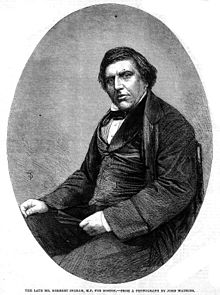Herbert Ingram
| Herbert Ingram | |
|---|---|
 |
|
| Personal details | |
| Born | 27 May 1811 |
| Died | 8 September 1860 (aged 49) |
Herbert Ingram (27 May 1811 – 8 September 1860) was a British journalist and politician. He is considered the father of pictorial journalism through his founding of The Illustrated London News, the first illustrated magazine. He was a Liberal politician who favoured social reform and represented Boston for four years until his early death in a shipping accident.
Ingram was born at Paddock Grove, Boston, Lincolnshire, the son of a butcher. After being educated at Laughton's Charity School and the free school in Wormgate (a street in Boston), he was apprenticed as a fourteen-year-old to town printer Joseph Clarke. When Ingram finished his training he moved to London where he worked as a journeyman printer.
In 1832 Ingram established his own printing and newsagents business in Nottingham, in partnership with his brother-in-law, Nathaniel Cooke. As a newsagent he noticed that when newspapers included woodcuts, their sales increased. He concluded that it would be possible to make a good profit from a magazine that included a large number of illustrations. However, it was to be a while before he could put this theory into practice. The newsagent business failed to make much progress until Ingram purchased the rights to a laxative known as Parr's Life Pills. The profits from marketing these pills provided the capital which enabled him to set up and publish The Illustrated London News.
Ingram moved back to London and after discussing the matter with his friend, Mark Lemon, the editor of Punch, he decided to start his own magazine – The Illustrated London News. The first edition appeared on 14 May 1842. Costing sixpence, the magazine had sixteen pages and thirty-two woodcuts and targeted a broadly middle class readership. It included pictures of the war in Afghanistan, a train crash in France, a steam-boat explosion in Canada and a fancy dress ball at Buckingham Palace. That pictorials were viewed as being as important as text for reporting was clear from the first issue, which stated that the aim was to bring within the public grasp "... the very form and presence of events as they transpire; and whatever the broad and palpable delineations of wood engraving can achieve, will now be brought to bear upon every subject which attracts the attention of mankind".
Ingram was a staunch Liberal who favoured social reform. He announced in The Illustrated London News that the concern of the magazine would be "with the English poor" and the "three essential elements of discussion with us will be the poor laws, the factory laws, and the working of the mining system". Despite arguing the case for social reform, the paper claimed to be nonpartisan. Its first editorial had stated, "We commence our political discourse by a disavowal of the unconquerable aversion to the name of Party." However, this may have been no more than a desire to gain the widest possible readership, because as time progressed the paper displayed its Whig inclination. It showed moderation and caution in its reportage and this extended to that of the Irish Famine, which was largely sympathetic even if not quite able to denounce the inadequacy of government policy or the ideas of prevailing economic or political orthodoxy. There was none of the overt negative stereotyping found in the most acerbic Punch cartoons. Overall there was an attitude that England had a responsibility towards the victims of what was largely interpreted as a natural disaster.
...
Wikipedia
